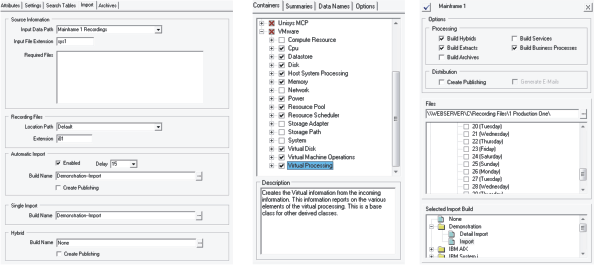


RG Solutions® has extensive means for the formation of data within its processing environment.
The user has control over the settings, rules, processes, and scope of data formation. The
processing can be done manually or set up for unattended processing on a periodic basis.
|
|
Major Data Features |
|
Imports
|
This is external data that is brought into the processing environment by the
Import Processing. The transformation of the data is dependent upon the
processing present in the corresponding Collection. The included types of data are
dependent up on the user selection and processing options.
|
Hybrids
|
Hybrid Data is data that is constructed from information that is already contained
in the repository, service, or business process. Generally speaking, this process is
used to combine two data types to form a third (hybrid) data type.
|
Extract
|
Extract Data is similar to imported data, but the source of the incoming data is
repositories, services, and business processes that are the offspring of the entity.
This processing is usually used for the consolidation of similar types of processing.
|
Archive
|
Archives are the consolidation of Data Sets into a more summarized form and
may include Week, Month, and Year based consolidations. Archives contain both
Container and Summary Data.
|
Recreate
|
All data stored within the processing environment can be recreated using revised
information. It can be done to add additional data from the incoming sources, or
when data processing values have changed and the data must be reformed.
|
Major Processing Capabilities
|
|
ABC
|
The internal processing uses Activity Based Costing techniques for the allocation
of usage. Generally, the allocations are determined by the processing based on
the user defined requirements. ABC is also used for the usage allocations based
on system sharing.
|
Workloads
|
Workloads are a method of classifying the actual system processing into different
groups of similar processing. These groups could be business oriented or they
could be IT oriented. There can be more than one classification requirement and
the program processing is designed to handle multiple classification processes.
|
Sharing
|
The processing environment supports system sharing. This type of sharing is
when a system is using the information from one or more other systems. The user
defines the sharing relationship and the system processing automatically
determines the shared usage.
|
Automatic
|
The creation of data within the processing environment can be done automatically
or manually by the user. For automatic processing, the program allows for a
Service or a Scheduled Program to complete the needed processing.
|
Rule Based
|
The formation of workloads and other user defined values is done using a rule
based table. The table resembles a spreadsheet and contains the “lookup” values
needed by the processing. When the processing matches a rule to the data, the
rule will contain information used by the processing to fulfill the requirements.
|
Metering
|
The internal processing uses a metering framework for determining usage values.
A Metering Framework uses a combined value of power over time to measure
processing usage.
|